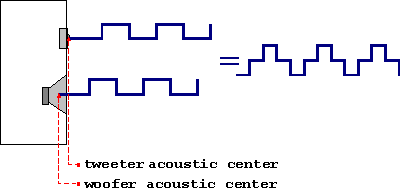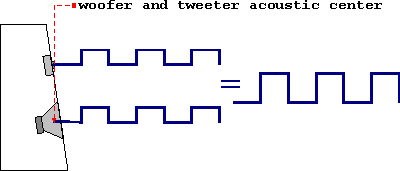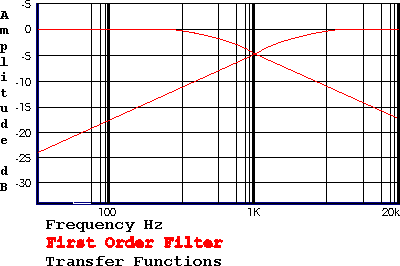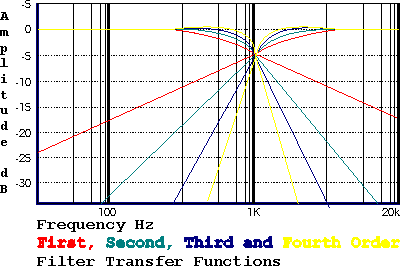| |
||
|
|
Loudspeakers and Time Coherence |
|
|
What You Don't
Know Can Hurt You A technical discussion by Pat McGinty, designer for Meadowlark Audio
THE WORLD OF SPEAKERS IS DIVIDED INTO JUST TWO CLASSES:TIME COHERENT SPEAKERS AND TIME INCOHERENT SPEAKERS.
|
||
|
|
HERE IS WHAT YOU SHOULD KNOW ABOUT THIS |
|
|
Contents
Slanted Baffle Aligns Crossovers, aka
Filters, Step Response - Other Troubles
|
Any musician can tell you that the 'tools of the trade' are pitch, loudness and timing. Likewise, electronic music reproduction is a three dimensional problem: the domains of which are not merely frequency and amplitude, but also: time. This may seem obvious once it is pointed out, but in high end audio we seem to turn a blind eye, or a deaf ear to the issue of correct timing in our stereo systems. The specifications commonly used to describe speakers dwell almost entirely upon frequency and amplitude while revealing nothing at all about time domain fidelity. For good reasons, most manufacturers of speakers are very happy with this state of affairs. In the following discussion you will see why fidelity in the time domain is rarely discussed, and why it is so important.
|
|
|
A time coherent speaker is one whose acoustic output is a duplicate of its electrical input. 'Don't all speakers try to do that?' you might ask. No, they do not! Most speakers just try to reproduce all frequencies at the same relative amplitude (flat frequency response) and completely disregard proper timing. These speakers are called time incoherent. |
This discussion regards the engineering principles of time coherence as well as the important practical and psychological considerations involved. Some of this stuff can be pretty difficult to grasp, even for us in the industry. So, I've done my best to make these ideas simple, but if you get stuck, just keep reading.... there's no single idea upon which the whole argument turns, and things do get easier as you go along. |
|
|
|
SLANTED BAFFLE ALIGNS ACOUSTIC CENTERS |
|
|
With the rare exception of single driver speakers, the only way to achieve time coherence is by physically offsetting the drivers, in our case by slanting the baffle, and by employing first order crossovers (that is the single most important sentence in this paper). The idea of aligning the drivers in time by slanting the baffle is easy to grasp. The time consequences of crossover design are a bit tricky. We'll start with the first idea. When two drivers are mounted on a vertical baffle - the place where the tweeter's sound originate,
|
its "acoustic center", is actually an inch or so out in front of the woofer's acoustic center. Because all frequencies travel at the same velocity, the sound from the tweeter will arrive at the listener's ears before the sound from the woofer. As you can see below, if the sound were (for the sake of graphic clarity) a square wave - the listener would not hear a square wave at all. Though the listener might hear all frequencies at the proper amplitude, the waveform is disturbed in the time domain. Hence the listener hears something quite different from what is actually on the recording. |
|
|
|
||
|
acoustic centers not aligned
|
||
|
acoustic centers aligned
|
||
|
|
||
|
|
CROSSOVERS, aka FILTERS, aka X/Os |
|
|
Because crossover circuits are hidden from view and somewhat hard to understand they are often overlooked by the press and disregarded by buyers as an issue in speaker design. Actually, the crossover has more to do with how a stereo system sounds than any other component in the audio chain. Crossover design is at least as critical as the design of drivers and cabinets, and, like it or not, grossly outweighs your choice of amps, preamps, players and wires.
The primary purpose of the X/O is to |
divide the signal into frequency bands - to send bass to the woofer and treble to the tweeter. To do so it attenuates the signal in the frequencies that are not desired. The rate of this attenuation is referred to as a filter’s ‘order’. Filters attenuate in multiples of six decibels per octave 6dB/octave, 12dB/octave, 18dB/octave, etc. and are referred to as first, second, third, etc. ‘order’. An octave is either a doubling, or halving of frequency, and six decibels means either a quartering or quadrupling of amplitude. So, a first order filter is down to 1/4 power at one octave, A second order is down to 1/16 power at one octave, 3rd order is at 1/64 power, and a 4th passes just 1/256th of the power at one octave!
|
|
|
|
||
|
|
||
|
Now, chopping off a driver’s output really quickly is a very, very attractive idea. A designer can greatly expand each driver’s usable band, perhaps increase the whole system’s power handling, and minimize the overlap area between drivers. Most importantly, much cheaper drivers can be made to do the job. Steep filters even take most of the trouble out of getting a flat frequency response. A great bargain. One would think....
|
||
|
TOP OF PAGE NEXT PAGE FORMAT FOR PRINTING (20 PAGES) |
||




